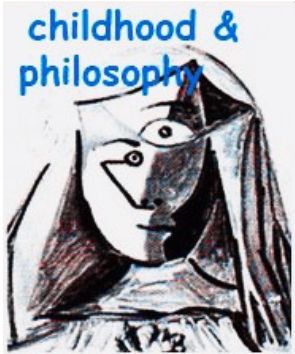maravilhamento primeiro como um broto de virtude intelectual
DOI:
https://doi.org/10.12957/childphilo.2023.66675Palavras-chave:
FpC, maravilhamento primeiro, broto de virtude, virtude intelectual.Resumo
Este trabalho de investigação defende que o conceito de Maravilhamento Primeiro (primal wonder) na FpC, proposto por Thomas E. Jackson, pode ser considerado o desabrochar da virtude intelectual. Minha interpretação desse conceito foi inspirada pela visão de cultivação moral de Mengzi e pelos relatos eudaimonistas de virtudes éticas, de Aristóteles. De acordo com Mengzi, os seres humanos possuem quatro brotos inatos de virtude, e o objetivo da educação moral é nutrir esses brotos de moralidade para que cresçam e se tornem virtudes amadurecidas. Em termos de FpC, Jackson afirma que todos nós nascemos com um sentimento especial de maravilhamento, ao qual ele se refere como “maravilhamento primeiro”. Sintetizando essa afirmação à metáfora agrícola de brotos morais de Mengzi, posso dar um passo à frente e argumentar que esse maravilhamento inato a cada criança pode ser visto como o desabrochar da virtude. Além disso, uma vez que o maravilhamento primeiro das crianças tem sido transformado em virtude através da implementação da FpC em sala de aula, esse admirável traço de caráter, eu sugiro, deve ser compreendido como uma virtude intelectual, de acordo com as virtudes éticas aristotélicas. Isso porque a virtude do maravilhamento pode promover o florescimento intelectual das crianças, o que é totalmente endossado pelas afirmações de Aristóteles de que o tipo mais feliz de vida é ser um filósofo e que a filosofia começa no maravilhar-se. Em resumo, se o maravilhamento primeiro como um broto de virtude intelectual pode levar ao bem maior para os seres humanos, então um dos principais objetivos educacionais de fazer filosofia com crianças, eu sugiro, é transformar seu maravilhamento primeiro em um hábito virtuoso para que elas possam viver uma vida examinada.
Downloads
Referências
Adkins, A. W. H. (1978). Theoria versus Praxis in the Nicomachean Ethics and the Republic. Classical Philosophy, 73(4), pp. 297-313.
Anderson, Anastasia. (2020). Categories of Goals in Philosophy for Children. Studies in Philosophy and Education, 39(6), pp. 607-623.
Aristotle. (1998). The Metaphysics. Translated by Hugh Lawson-Tancred, Penguin Books Ltd.
Aristotle. (1999). Nicomachean Ethics. Translated by Terence Irwin. 2nd ed., Hackett Publishing Company.
Butnor, Ashby. (2012). Critical Communities: Intellectual Safety and the Power of Disagreement. Educational Perspectives, 44(1- 2), pp. 29-31.
Carson, Rachel. (1965). Sense of Wonder. Harper & Row.
Downing, Lisa, "George Berkeley", The Stanford Encyclopedia of Philosophy (Fall 2021 Edition), Edward N. Zalta (ed.) https://plato.stanford.edu/archives/fall2021/entries/berkeley/. Access 19 Jan 2023.
Fisher, Kathleen M. (2000). Curiouser and Curiouser: The Virtue of Wonder. The Journal of Education, 182(2), pp. 29-35.
Jackson, Thomas E. (2019). Primal Wonder. The University of Hawaii Uehiro Academy for Philosophy and Ethics in Education. Available in: https://p4chawaii.org/wp-content/uploads/Primal-Wonder-Final-7_2019.pdf.
Jackson, Thomas E. Dr. Thomas Jackson on p/Philosophy. Youtube, 29 Oct. 2010, Available in: https://www.youtube.com/watch?v=pylLnHzfwI0.
Jackson, Thomas E. (2004). Philosophy for Children Hawaiian Style—‘On Not Being in a Rush…' Thinking: The Journal of Philosophy for Children, 17(1-2), pp. 4-8.
Kitchener, Richard F. (1990). Do Children Think Philosophically? Metaphilosophy, 21(4), pp. 416-431.
Kraut, Richard. (2018). Aristotle’s Ethics. Stanford Encyclopedia of Philosophy, Available in: https://plato.stanford.edu/entries/aristotle-ethics Accessed: 15 Jun. 2018.
Kristjánsson, Kristján. (2016). Flourishing as the aim of education: towards an extended, ‘enchanted’ Aristotelian account. Oxford Review of Education, 42(6), pp. 707-720.
Kristjánsson, Kristján. (2018). Chapter 10: Scientific Practice, Wonder, and Awe. In Deane-Drummond, Celia, et al., Virtue and the Practice of Science: Multidisciplinary Perspectives. Pressbooks. Available in: https://pressbooks.pub/virtueandthepracticeofscience/chapter/scientific-practice-wonder-and-awe/.
Makaiau, Amber S. & Chad Miller. (2012). The Philosopher’s Pedagogy. Educational Perspectives, 44(1- 2), pp. 8-19.
Matthews, Gareth B. (1980). Philosophy and the Young Child. Harvard University Press.
Mengzi. (2008). Mengzi: With Selections from Traditional Commentaries. Translated by Bryan W.
Van Norden. Hackett Publishing Company.
Piaget, Jean. (1931). Children’s Philosophies. InCarl Murchison, ed., A Handbook of Child Psychology. Clark University Press. pp. 377-391.
Plato. (1992). Theaetetus. Translated by M. J. Levett. Hackett Publishing Company.
Rolston III, Holmes. (2003). Value in Nature and the Nature of Value. Environmental Ethics: An Anthology. Edited by Andrew Light and Holmes Rolston III. Blackwell Publishing. pp. 143-153.
Ryan, Sharon. (2013). Wisdom. Stanford Encyclopedia of Philosophy. Available in: https://plato.stanford.edu/entries/wisdom/. Accessed: 4 Feb. 2023.
Schinkel, Anders, et al. (2023). Human Flourishing, Wonder, and Education. Studies in Philosophy and Education, 42, pp. 143-162.
Tobia, Kevin Patrick. (2015). “Wonder and Value.” Res Philosophica, 92(4), pp. 1-26.
Vansieleghem, Nancy & Kennedy, David. (2011). What is Philosophy for Children, What is Philosophy with Children—After Matthew Lipman? Journal of Philosophy of Education, 45(2), pp. 171-182.
Wheeler, Michael, "Martin Heidegger", The Stanford Encyclopedia of Philosophy (Fall 2020 Edition), Edward N. Zalta (ed.), https://plato.stanford.edu/archives/fall2020/entries/heidegger/ Accessed: 6 May. 2023.




